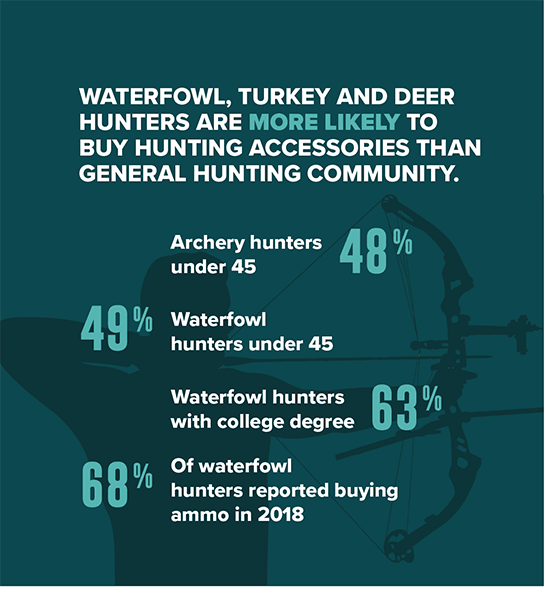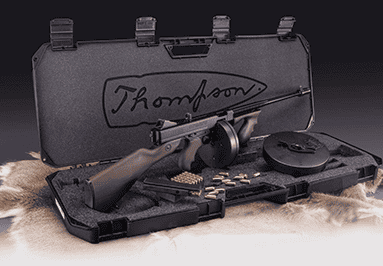Examining Segments Of the U.S. Hunting Market
Anyone familiar with the sport of hunting knows no two hunters are the same. While all hunters share a common passion for pursuing game in the field and connecting with the great outdoors, the species they chase may be wildly different based on their location and interests. To some, there’s no greater thrill than to flush and shoot birds over pointers. Others prefer the strategy, stealth and determination required to locate and take a trophy buck or gobbler. Within big-game hunting, most opt to use rifles — others insist on hunting only with bows. Then there are hunters who enjoy a variety of hunting types, employing different techniques and chasing several species throughout the year. For marketing purposes, there are important differences between these diverse types of hunters. Understanding these distinctions is key for effectively reaching your customers through marketing campaigns and earning their respect and business.
Identifying Habits How do we identify the differences between hunters based on the game they pursue? Luckily, there are several data sources out there that describe U.S. hunters, including their demographics, purchases and habits of hunters based on the different types of game pursued. The first is the U.S. Fish and Wildlife Service which produces the National Survey of Fishing, Hunting and Wildlife-Associated Recreation with input from state wildlife agencies.
(This free report can be found at: https://bit.ly/2JNFhuC.) While highly accurate and insightful, the results are limited to the following broad categories: big game, small game, migratory birds and other species. Those interested in examining hunters who pursue specific species will need to conduct some custom analysis of this publicly available dataset, an undertaking that requires considerable analytical skills. The dataset itself is only updated every five years. Another data source that provides similar insights on various groups of hunters is Southwick Associates’ Hunter Segment reports, which examine deer hunters, waterfowl hunters, turkey hunters and archery hunters. Custom reports on other types of hunters are frequently provided, too. These reports are based on a national panel of hunters who report their hunting and shooting activities every two months through HunterSurvey.com and ShooterSurvey.com. Aggregating a year’s worth of these responses allows for a robust look at several key segments of hunters. Notable Differences The key differences between various types of hunters are apparent when delving into the data. One thing that immediately stands out comparing those who hunt with archery equipment versus the greater hunting community at large is, on average, archery hunters tend to be younger. In 2018, 48% of archery respondents were under 45 years old — compared to just 37% of all hunting respondents. Obviously, archery hunters are in the market for some different products versus firearms hunters, but there’s also a lot of overlap in the products they buy. all three of these groups tend to purchase hunting accessories more frequently than the general hunting community.
All three of these groups tend to purchase hunting accessories more frequently than the general hunting community.
However, this age gap leads to differences in the way archery hunters shop — more frequently online and via feedback from their peers — as well as the media they consume. Smart companies will target each audience using the right mix of online and offline media and sales approaches based on that audiences’ unique preferences. Besides age, other demographic indicators, such as gender, education and household income are largely consistent between archery hunters and the greater hunting community. Another interesting comparison is waterfowl hunters versus those who target other key species such as deer and turkey. Waterfowl hunters also tend to be relatively young, with 49% of waterfowl hunters being under 45 years old. By contrast, just 39% of deer hunters, and 35% of turkey hunters are under the age of 45. Despite being younger on average, waterfowl hunters also tend to be more highly educated — with 63% reporting a bachelor’s degree or higher. Deer and turkey hunters tend to have a bit less education, both completing college at a rate of around 50%. However, in this case more education doesn’t necessarily translate into higher earnings as household income is only slightly higher among waterfowl hunters than the other two groups mentioned here. >Hunting Game Impacts Buying Tendencies There are also significant differences in the types of items purchased by these groups of hunters. Unsurprisingly, waterfowl hunters are more likely to purchase ammunition each year than deer or turkey hunters, as their sport generally involves more shooting. In 2018, 68% of waterfowl hunters reported buying ammo, compared to 58% of deer hunters and 61% of turkey hunters. Waterfowl and turkey hunters are both more likely to purchase clothing and apparel more regularly than deer hunters (41% of waterfowl hunters and 40% of turkey hunters bought hunting clothing or apparel in 2018, compared to 36% of deer hunters). And all three of these groups tend to purchase hunting accessories (items such as stands, decoys, calls, etc.) more frequently than the general hunting community. There are also important differences in shopping and brand preferences between these groups. For more information, please contact Southwick Associates
at Ben@SouthwickAssociates.com or Nancy@SouthwickAssociates.com, or visit www.southwickassociates.com.







